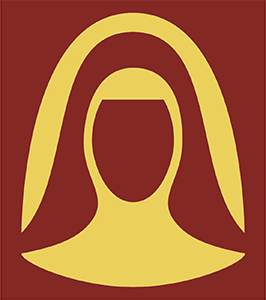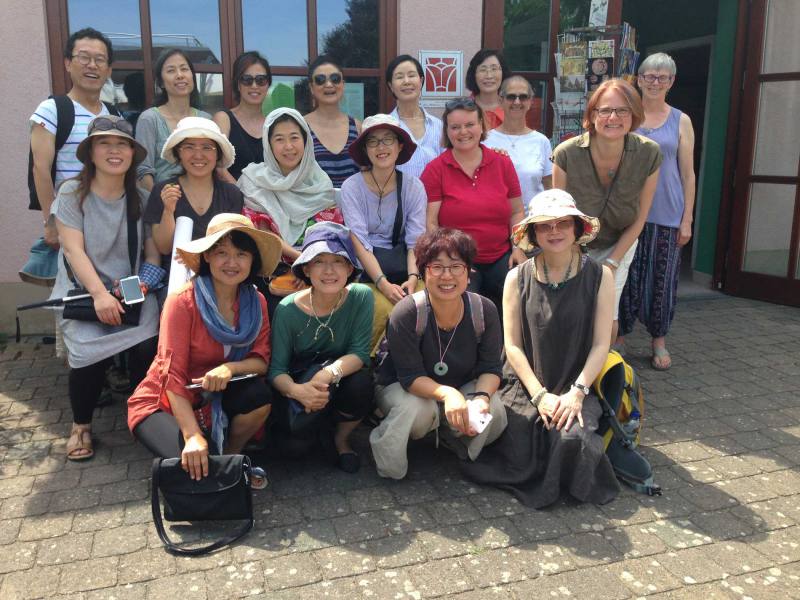Over many years I developed a deep fondness for Hildegard von Bingen. I was never sure why – it was just “there” within me. I was introduced to her life by a friend when I was living in Rome, before Hildegard became a Saint and Doctor of the Church. The story of her life fascinated me. Maybe, her response to a restricted life and to a narrow society and church of her time spoke to my own experience in the 20th and 21st Century – in a different way. I am a vowed religious. And in recent years I have been in leadership in my community. Hildegard had undertaken a life within the walls of an abbey and she too was the leader of her community. But she flew over the walls – in her articulation of her visions, in her leadership of her community, and in her work with herbs and medicine, and in her music.
On 26th July 2015, I joined the Pilgrimage group in Köln, Germany, and we set off together! Over 15 days along the Rhine valley where Hildegard had lived, worked, preached and taught. I was both excited and nervous! I had never before undertaken anything like this…! But, then neither had the 15 other participants, mostly from South Korea. So, we were “in this together”!
Köln was a great place to start. We gained some insight into the early history of the city as a Roman colony, and the importance of the Rhine River, the art and architecture of the medieval period, and the theology and devotion that existed at around the time of Hildegard. The days in Köln gave context to Hildegard’s time, and highlighted earlier events that influenced her.
During our days at St Goar, the visit to the Benedictine Abbey of Maria Laach, a beautiful and special place, gave us an insight into a “working abbey”, and thus into the sort of life Hildegard had lived. At one point when Fr Peter’s mobile phone trilled, I thought to myself: how Hildegard would have embraced the technology to get her message out! We were very lucky to visit old and the new libraries where thousands of volumes are stored, and where some books, centuries old, are kept.
I thought about the centuries of searching for knowledge and learning that these monks, that Hildegard herself, had taken part in. For Hildegard, her own contribution to research and learning in her time was considerable: Music, art, medicine, herbs and plants and advice for those who knocked at the Abbey door.
We visited the Rupertsberg, the original site of Hildegard’s monastery, tucked away beneath what is a group of commercial buildings – an oasis in the town. And we stayed at the Hildegard Forum on the Rochusberg – enjoying the wonderful hospitality of the Forum and its gardens.
I felt that Hildegard was “there” with us, with me. Music and song was important to her, one way that she praised her God. She loved to dance and to sing, she wrote and performed music! She encouraged her sisters to sing and enjoy the beauty of music and song. This moment will live on in my heart.
Throughout the pilgrimage days we gathered each morning for meditation which was led by one of the group. We had the opportunity to experience Tai Chi and other forms of movement and meditation. I think this time became precious for all of us.
Our pilgrim group was welcomed to the Bahn Mühle, in Disibodenberg, which is a treatment centre for young people dealing with addictions. I have worked with people with addictions, and I was very touched by the generosity shown to us by the Director and staff of this centre. We stayed in the guest house and we catered for ourselves. A special part of this time was the opportunity for us to cater for each other, in loving service. We had learned about the food and plants Hildegard used and recommended, and so the aim was to use “her” food as much as we could. Our meals were fresh, delicious and plentiful! We heard from Annette on Hildegard’s Scivias visions and mandalas, we learned more about German history from Britta, and about the herbs and plants Hildegard knew and wrote about and used. But what was special about our time in the guest house at Disibodenberg, was that we formed our own little “community”.
I know the ruins of Disibodenberg abbey are important – Hildegard spent 40 years there – and they are very picturesque on top of the hill in the forest, but this place was not as important for me as Eibingen, where her relics now are. For me, Hildegard’s shrine was where I felt her spirit to be most “real”; it’s where she is “accessible” to ordinary people, in the valley below the Abbey that is named in her honour. While Hildegard lived a monastic life, she was also accessible to the people of her time. I hope that now and into the future she will become much better known, much more accessible as her works and writings are translated into other languages. This Doctor of the Church, with her cosmological understanding and message of Divine Love deserves to be much better known and understood. Perhaps some of the wisdom she imparted hundreds of years ago can touch the hearts of people today and guide them on their life’s way!
A Pilgrimage – yes, in a way!
An experience – absolutely, yes!
Caroline Price, rgs
Melbourne, Australia
26 October 2015



